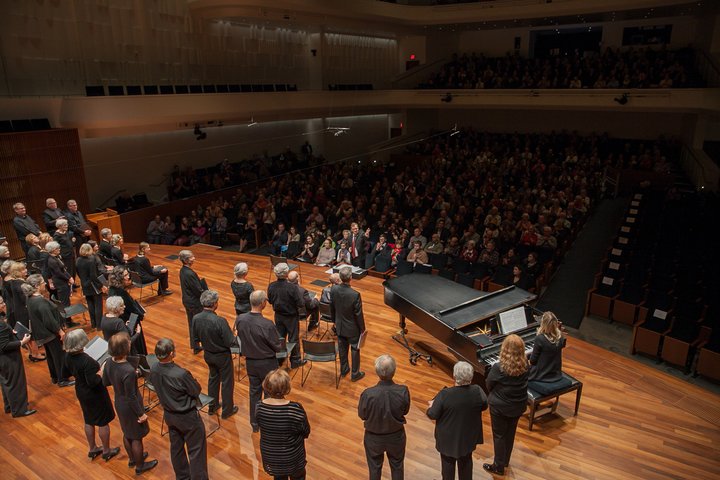
Winter Concert at Minnesota Opera. Credit: RJL Photography
Case Summary
Minnesota Opera sought and successfully built organizational support and buy-in for their Seeding Vitality Arts pilot program, “Voices of Opera.” The older adult community members’ incredible interest, the education department’s commitment to designing responsive programming, and the board’s involvement in the program itself were the building blocks of a creative aging infrastructure. Minnesota Opera is a model for other organizations as they grasped the importance of full organizational support from the beginning to ensure that a program is sustained beyond a grant-funded pilot.
Challenge
Prior to the launch of “Voices of Opera,” Minnesota Opera’s education programming priorities were primarily focused on youth. This program marked their first opportunity to engage older adult patrons as artmakers. They were unsure if older adults would be interested in learning opera, and initially worried that there may not be the kind of administrative and executive support needed to prioritize and sustain creative aging programming.
In order to succeed, the program needed to be as barrier-free as possible. Through participation in the program, the myth that opera is an untouchable artform meant only for trained professionals would be debunked. The biggest planning challenge was that the teaching artists did not know what the skill levels of participants might be.
Learning and creative expression were placed at the heart of the program’s goals. An educational culture shift needed to be embraced by Minnesota Opera’s leadership, as well as the participants, to ensure the sustainability of the program.
Solution
Due to the organization’s efforts to design an accessible yet unique program that built opera skills, the classes wound up being oversubscribed. As a result, the Opera began to view their education programs as “Opera for All Ages.’
To build institutional support of the program, Chief Learning Officer, Jamie Andrews, presented at several board meetings and encouraged their participation. Board members signed up to participate, and they became champions for the program. These actions contributed to a shift in the culture of the organization and how they perceived older adults.
“Opera for All Ages” was integrated into their operations and strategic thinking. The organization has become an advocate for creative aging programming. They now perceive older adults as active, vital, creators of art work and not just passive audiences. Overall, Minnesota Opera has begun to support a more inclusive and equitable cross-section of their community.
Organizational Profile
Host Organization Name
Minnesota Opera
Host Organization Description
From their website: Minnesota Opera combines a culture of creativity and fiscal responsibility to produce opera and opera education programs that expand the art form, nurture artists, enrich audiences, and contribute to the vitality of the community. In 1963, the commission of a world premiere sparked the creation of a Twin Cities opera company focused on the rare and avant-garde. 54 years later, Minnesota Opera is one of the nation’s most distinguished opera companies, known for its world-class artistry and innovative productions. To date, the company has produced 44 World Premieres, 12 American Premieres, and countless revivals. Annually, the company serves nearly 370,000 individuals with core programs, and serves over 50,000 youth and adults through its state-wide education and outreach and new works initiatives; formal education programs serve 24,000 youth and adults.
Host Organization Website
Minnesota Opera’s Seeding Vitality Arts program, “Voices of Opera,” was an choral program for active seniors ages 55+. One hundred and fifty older adults learned about, made and shared opera.
The program was designed so that participants would learn, build and improve upon specific artistic skills under the instruction of professionals. The program also aimed to establish a new peer group for participants. It was Minnesota Opera’s intent that a collective experience of learning and performing music together would create one community.
Voices of Opera offered three workshop series led by a professionally trained teaching artist and pianist/vocal coach. Each series consisted of nine, 90-minute sessions, followed by two public performances. Sessions were held once a week, at three different locations — in Minneapolis, in St. Paul, and in Red Wing. The program was coordinated and taught by Matthew Abernathy. Sheldon Theater, Lyngblomsten and Westminster Presbyterian were community partners.
Learning Objectives
Minnesota Opera’s learning objectives were to introduce and teach music/singing skills, theater skills, and textual analysis skills.
Facility Details
Minnesota Opera partnered with three organizations for rehearsal spaces, particularly theaters and houses of worship. Each facility was large enough to accommodate 50+ participants and had good acoustics.
Material / Equipment Details
Light: Pencils, large-print sheet music and binders were needed for each session.
Heavy: A piano, either portable or provided by the facility, was necessary to conduct each session.
Recruitment and Marketing Details
Minnesota Opera sent postcards to their mailing list, and the programs were advertised in their mainstage programs.
Culminating Event Details
Each series culminated in a semi-staged opera performance in a theater. Concerts were combined with youth opera performances to create cross-promotion. Participants also performed the national anthem (in collaboration with other choruses) at a St. Paul Saints game.
About the Initiative
Seeding Vitality Arts US
Aroha Philanthropies’ Seeding Vitality Arts US enables a diverse cohort of organizations across America to develop and implement high quality, intensive arts learning opportunities for older adults.
The initiative’s goals are to:
- Demonstrate the power and impact of creative aging programs to a broad national audience
- Encourage arts and cultural organizations to develop participatory arts education programs for older adults
- Encourage organizations that serve older adults to develop arts education programming
- Refine and disseminate effective program models
Our mentality has always been that we want people to actually participate in opera rather than just having us lecture you about [it], right?
teaching artist
Case Study Details
case study topics
Intergenerational Programing, Organizational Commitment, Sustainabilityorganization type
Arts Organizationsart form
Performing Artsprogram site type
Arts Organizations, Houses of Worshippopulation density
Urbanincludes virtual programming?
Nosession details
8-12 sessions @ 90-120 min.
year
2016funding source
Private Foundationfunder
Aroha Philanthropies